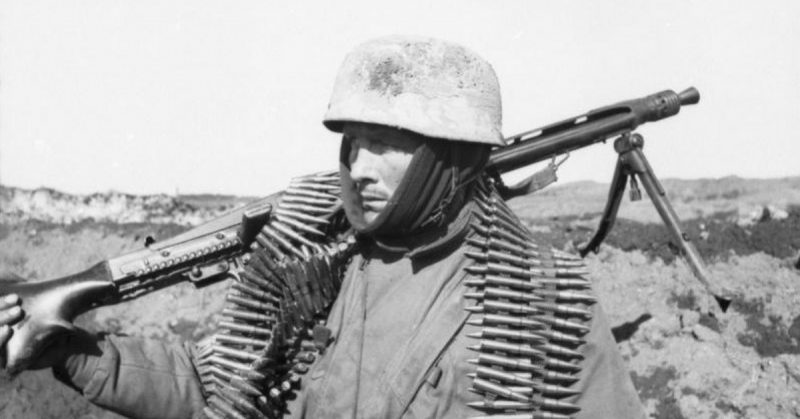Machine-guns were essential during WWII. Not until the final year was anything approaching a modern assault rifle seen on the battlefields. As a result, specialist automatic weapons were vital to laying down heavy fire, both as a part of attacks and as a defensive measure.
The German Maschinengewehr 42, or MG42, was one of the best machine-guns of the war, both in combat and in ease of production. It set the standard for machine-guns in the years that followed, and as such was the most important machine-gun of the war.
The MG34
The MG34 preceded the MG42.
The MG34 was itself a significant weapon. Recoil-operated and air-cooled, it was light enough to be portable while powerful enough to be deadly. At 900 rounds per minute, its rate of fire was unmatched when it came into service.
The MG34 was developed during the 1920s when Germany was quietly finding ways to circumvent the Treaty of Versailles and rebuild its armed forces. Hitler’s repudiation of the treaty in 1936 opened the way for the gun to be widely distributed. It was taken to Spain by German forces supporting Franco’s coalition during the Spanish Civil War, where it was field tested, and troops gained experience using it.
The MG34 provided the firepower, maneuverability, and reliability that the German army wanted from a machine-gun. It was, however, very expensive to produce. That became a serious drawback as Germany undertook a massive process of rearmament.
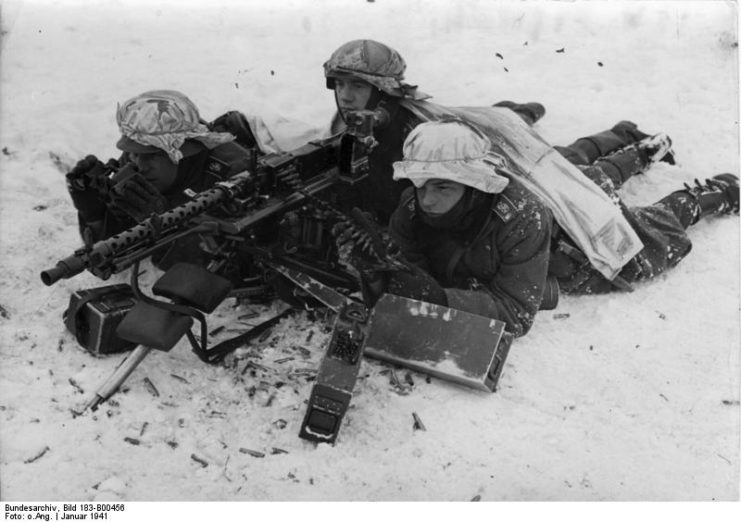
Building Something Better
The solution to the problem was the MG42. Designed by the weapons engineers at Mauser, it built on their previous machine-gun designs, including the MG34. Ideas were also incorporated from experimental weapons captured from the Poles during the 1939 invasion.
Broadly speaking, the MG42 was like the MG34. Strong, simple, and relatively light, it used a recoil-operated system to achieve sustained fire. A muzzle trap added to its efficiency by keeping pressure high until well after the bullet left the barrel.
The main difference in design was in the bolt and locking system. Rather than turning while locked together, bolt and barrel recoiled straight back. An extension at the back of the barrel used cams and locking studs to close the barrel and bolt together while pressure was high in the barrel, then separate them automatically. The movement of the bolt triggered an ammunition feed arm that supplied cartridges at a faster rate than any previous machine-gun while maintaining a complete accuracy of feed, avoiding jams.
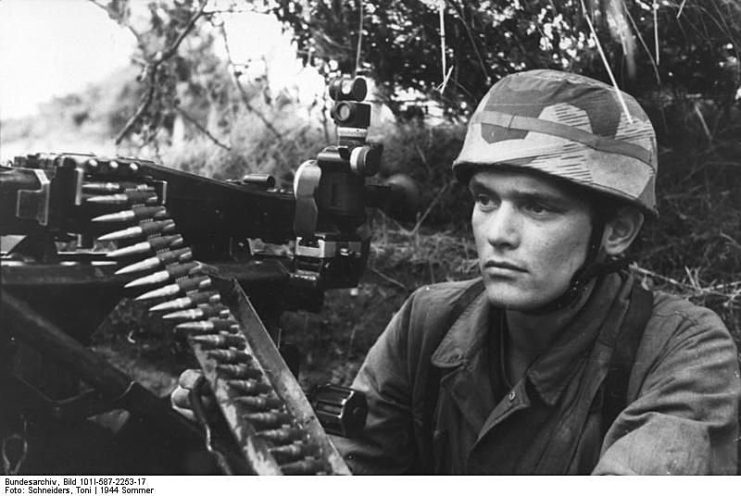
Battlefield Practicality
The feed system provided one of the MG42’s major advantages – its high rate of fire. At 1500 rounds per minute, it was significantly better than the MG34’s 900 rounds and nearly double the firepower of other predecessor weapons. It was a devastating weapon, invaluable for providing the shock and damage needed in the early phases of an assault. The sound of the gun alone made it an intimidating beast.
A folding bipod was ingenious for firing at close range. It could be quickly stabilized and used by troops on the move. The MG42 could be combined with a Lafette 42 tripod which provided greater stability at the price of mobility. Coupled with indirect-fire sights, it made for deadly sustained fire. As such, it was invaluable in laying down suppressing fire against enemy troops.
The MG42 and its tripod could be adapted to circumstances. It could be turned into a portable and efficient anti-aircraft weapon. It was a simple adaptation that was particularly important in the latter stages of the war when the Allies gained dominance in the air.
Tough, reliable, simple, and easy to use, the MG42 followed the path set down by the MG34 but went much further.
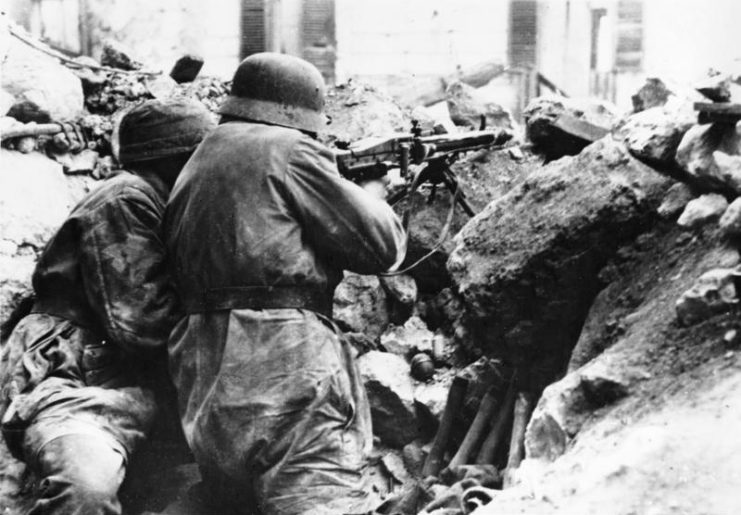
Ease of Production
Ease of production was as important as battlefield superiority for the MG42. WWII was a fully industrialized war, in which the efficiency of a nation’s manufacturing made a huge difference to its capability in the field. For Germany to supply a gun to its troops in large quantities, that gun needed to be cheap and easy to manufacture.
The MG42 fitted the bill. It was cheaper, easier, and perhaps most importantly quicker to produce than the MG34. As such, it could easily be brought into action.
One of the most important features of the manufacturing process was stamped sheet metal. It was used as much as possible, including to make the barrel housing and the receiver. It made production easier, removed bottlenecks in the process, and contributed to the fast assembly of the MG42.
Metal stamping allowed a feature vital to the gun’s use – its barrel-changing mechanism. The high rate of fire led to barrels quickly heating up. It could be hugely problematic if the barrel overheated. An ingenious device allowed the gun’s crew to quickly change barrels to avoid the problem. The MG42’s optimum crew consisted of six men, enabling them to carry spare barrels and swiftly change them in action.
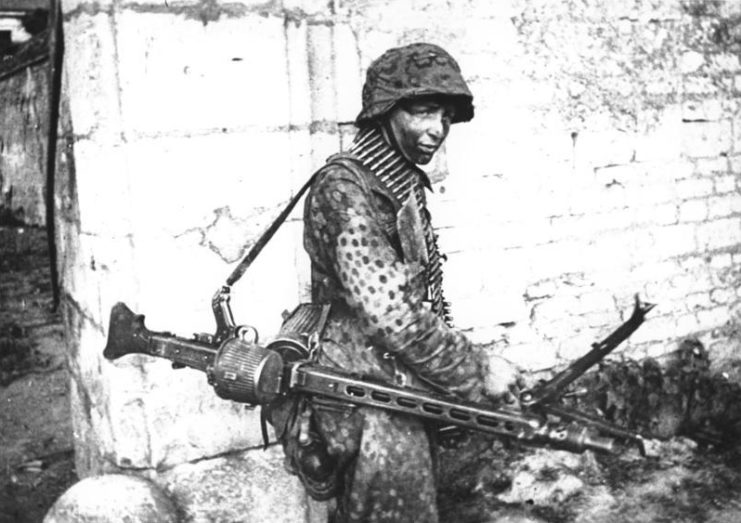
Lasting Impact
The MG42 was useful to German armed forces during WWII, but the real measure of its success is in the weaponry that has followed. As German and international manufacturers saw how effective it was, they adapted its technology into derivative guns.
In 1959, West Germany began using the MG1, almost identical but changed for use with standard NATO ammunition. Wartime stocks of the MG42 were rebuilt as the MG2 to enable them to also use the NATO ammo. The MG3 followed, made ou
t of lighter materials, and is still in use by the German military today.
MG42s and their derivatives have been used by dozens of armies in every corner of the world. It did not enable the Nazis to win WWII, but its impact on gun design meant it far outlasted the regime that created it.
Sources:
Christopher Chant (1986), The New Encyclopedia of Handguns
Wikipedia – accessed May 22, 2017
